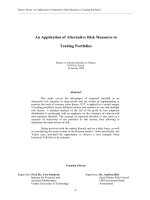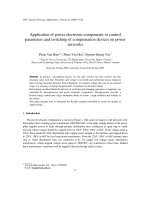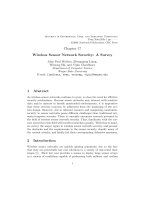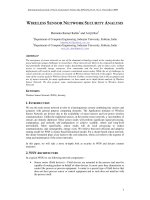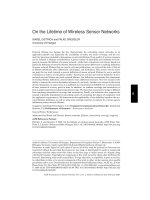Application of wireless sensor network to make transportation fleet information systems smart
Bạn đang xem bản rút gọn của tài liệu. Xem và tải ngay bản đầy đủ của tài liệu tại đây (667.29 KB, 6 trang )
International Journal of Computer Networks and Communications Security
VOL. 2, NO. 10, OCTOBER 2014, 355–360
Available online at: www.ijcncs.org
ISSN 2308-9830
Application of Wireless Sensor Network to Make Transportation
Fleet Information Systems Smart
ALI GHARAGOZLU1 and MEHDI IZADI2
1
The B.S student of the Mechanical engineering in Bu-Ali Sina University, Hamadan, Iran
2
Faculty of electrical and computer engineering, University of Tabriz, Tabriz, Iran
E-mail: ,
ABSTRACT
Traffic signs are tools to control and regulate movement, on streets and crossings. These signs individually
play their own essential role in reducing accidents and securing traffic. Unfortunately, thieves steal these
signs on suitable occasions to sell them as scrape in black market. Wireless sensor systems are of desirable
features including independence, being capable of expanding in remote and inconsistent places. They may
be assigned such operations as supervising traffic signs. This essay aims at study of some hierarchical
routing protocols or static cluster, introducing a new protocol through which we focus on clustering special
nodes having no-battery in contrast to ordinary nodes. The result is to obtain network more stability and
optimal energy consumption. The new protocol was tested on real characteristics of more than 600 traffic
signs in the city of Hamedan, run in MTALAB software. The findings are examined here.
Keywords: Wireless Sensor Networks, Routing Protocols, Static Clustering, Optimal Energy Consumption,
Life Cycle of the Network, MATLAB.
1
INTRODUCTION
To solve social and economic problems that the
people around the world face, researchers try to,
through such concepts as Smart City Week [1],
reach novel approaches to these problems, using
new technologies. Smart transportation is one of
these efforts. In this regards, we may refer to the
application of wireless networks and sensors in
providing new urban functions for smart cities a
new idea in communication of information in smart
cities is digital signs [2].
2
WIRELESS SENSOR NETWORKS
WSN refer to a collection of sensors
interconnected a wirelessly and all feel a specific
phenomenon. The number of these sensors may be
high and their distribution range may be vast. The
sensors in these networks may be located manually
or distributed randomly in places of interests to
function. The main propose of these network, after
establishment, is firstly to collects information and
secondly to make the life cycle of system as longer
as possible [3].
2.1 Tracking Targets
Tracking targets has recently attracted the
attention of scientists in operational and research
projects. Some of recently experimental projects in
field of tracking and supervision are:
Underwater tracking and surveillance: Aqua
nodes [4].
•
•
•
•
Border surveillance: Exscal [5].
System intrusion and recognition projects:
line- in the – sand [6][7].
Moving animals tracking in natural sources:
zebraNet protests [8].
Tracking using video camera: Mesh Eyes,
Cyclops – Sens Eye [9][10][11].
The issue of tracking in WSN may be defined as
a network of "n" wireless sensor nods formed to
track targets in a region. "M" targets are located in
this region. Sampling signals transmitted for
356
A. Gharagozlu and M. Izadi / International Journal of Computer Networks and Communications Security, 2 (10), October 2014
targets
(chemicals, vibrations, audio signals),
these sensing nodes recognize them or their
absence. In view of processing and formation of
network structure, algorithms may be categorized
into two distributed and concentrated ones. Under
the latter method, one node (or a central entity)
obtains information from the whole network
(assuming that the transmission of information
from all modes to this central
mode). Then,
the optimal structure (cluster of tree) is formed on
the basis of cross-network data. By cluster-based
method, a cluster is made of nodes before the
setting up of the net (static 1) or at the same time
as the target is recognized (dynamic)[12][13] . The
group head (cluster head 3) is determined. The
nodes send their data on the target is the related
cluster head [14]. The cluster head locates the
target after collection of data , sending the
concerned report to sink node [15] , based on tree
method , similar to methods based on cluster, and
before the start of network's operation or as soon
as the recognition of target . The tree- structure is
made of nodes; each mode sends its information to
the parent node. The collection of data to the root
node .The target is located and related report is
sent by the root to the sink. under the hierarchical
routing
methods
(based
on
clustering)
[16][17][18][19].The modes may process and
transmit to more vigorously while nodes may be
used to perform the sensing function in vicinity of
the target , consuming low level of energy. In fact
, the hierarchical method, forming clusters are
allocating special duties to cluster heads , may
greatly contribute to life cycle , energy efficiency
of system and comparability , avoiding single –
cross architecture . The hierarchical routing is a
basis for less energy demand of a cluster, through
aggregation and combination of data to reduce the
number of sent messages. Hierarchical routing
was mostly two-layer routing, one of which is
used to select the cluster head and the other is
allocated the duty to routing. However, the most
of technologies are not related to routing, they
speak of who and when the process or aggregation
of data, or allocation of channels [20].
3
ROUTING PROTOCOL
3.1 LEACH
This protocol is one of the most famous
hierarchical protocols for WSN (Figure 1) [21].
Under this protocol, the time is divided into equal
turns. Each turn is divided into two phases. The
second phase is related to the ordinary function of
the network, named stable phase. In the first phase,
based on comparison probability function CH is
chose. (Figure2) .The choice of CH is made in this
way that each sensing node chooses a number
between one and zero in case this number is less
than a fixed threshold. That node is chosen as Ch in
that turn. This probability function has been
selected in such a way that each mode is selected as
Ch once per determined number turns.
By doing so, the consumption of energy is
distributed over the net. Following the selection of
CHs in the commissioning phase of each turn, each
CH informs other modes of its selection. Each
mode selects its appropriate CH for itself. This fact
is notified to relate CH. As result, clusters are
formed.
At the next step, each CH provides it's clusters
modes with time planning, allocating each sensor a
phase to avoid the collision among data of sensors
in each cluster [22].
Fig. 1. LEACH protocol with cluster nodes
( )=
−
∗
∈
Fig. 2. LEACH possibility of implementing
3.2 SEP
SEP is one of hierarchical protocols for wireless
network, suitable for heterogeneous environments
respect o the energy. We also assume that these
sensors are not randomly distributed but the
selection of cluster head are based on the imbalance
of energy in the network [23].
Solution:
Selection of two parameters of PAdv and PNM.
Each node knows all energy of the network, they
respectively refer to the probability for being
cluster head for normal and power – holding modes
assuming.
3.2.1 Properties of SEP
•
Its energy consumption is balanced
357
A. Gharagozlu and M. Izadi / International Journal of Computer Networks and Communications Security, 2 (10), October 2014
•
The probability for choosing power –holding
modes to be chosen as cluster head is high.
The life cycle of the net is high.
It is comparable and dynamic.
•
•
. ( −
+ .
)×
=
×
Fig. 3. The number of cluster heads in each round in
heterogeneous environments
Averagely, the number of cluster head is chosen
on the basis of the formula reflected in the (Figure
3).
=
=
+∝.
Formula 2
)={
−
.
−
. (
)={
)
0
Fig.5 . Threshold
The selection of threshold for power –holding
nods are reflected in (Figure 5).
3.2.2
•
•
All
existing
routing
protocols
under
heterogeneous environment try to meet the balance
in the selection of cluster head among special and
ordinary cluster heads. This happens with the
probability function of selecting in each group. This
algorithm tries to take another probability in
addition to previous cases. These probabilities are
to take into consideration of special and ordinary
clusters for candidate cluster heads from ordinary
modes.
The algorithm of SNN selects the cluster head
among ordinary nodes in line with (Formula 2).
× ( +∝)
+∝.
The weight probability for ordinary and special
nodes are padv and pnm respectively.
(
NEW ROUTING PROTOCOL (SNN)
S(i).ENERGY
==0
&&
booln==true
&&
booln2==true && temp_rand <= ( pnrm*2 / ( 1 - pnrm *
mod(r,round(1/pnrm))))
Fig. 4. Weight probability
(
4
Comparison with LEACH
Complete consumption of additional energy in
power-holding node.
Longer life cycle is 26% higher than that of
LEACH.
S(i) =number of arrange among ordinary nodes;
booin= Boolean variables.
(tem_rand)= a numerical variable between 0 and
1.
SNN chooses ordinary cluster head based on
adjusting sensing range.
The adjustment of sensing range is a parameter
based on which an ordinary node fixed the change
to be selected as cluster head. This parameter
should be of distance with less than meter between
ordinary node of the candidate cluster head and
specific cluster head . Also, this parameter should
be in a distance less than one- meter between
ordinary node (candidate cluster head) and ordinary
one. Figures 4 and 5 show a sensing range.
5
PROCESS OF DATA TRANSMISSION
The data transmission may be performed 3
groups of nodes
1)
2)
3)
4)
Ordinary nodes
Ordinary cluster head
Special ( cluster head )
Ordinary nodes send their data to the
neighboring cluster head node. The
head may be either ordinary or
special.
358
A. Gharagozlu and M. Izadi / International Journal of Computer Networks and Communications Security, 2 (10), October 2014
In next section Figure 6 shows the distribution of
these under the case study ordinary cluster nodes
sends its own data or the data sent to it by a
member to neighboring cluster to the special cluster
head nodes in a shower manner. Figures 6 and 7
show the flow of data in WSN.
6
IMPLEMENTATION
Fig. 8. Flooding
6.1 Simulation
SNN clustering sensing radius '1' of Figure 9
shows. Featured cluster head node is red and green
cluster head nodes are normal.
Fig. 6. Transmission of ordinary node with ordinary
cluster head
Fig. 9. sensing radius '1'
Fig. 7. find the nearest cluster head by the cluster-heads
for ordinary
SNN clustering sensing radius '4' of Figure 10
shows. Featured cluster head node is red and green
cluster head nodes are normal.
Fig. 10. sensing radius '4'
Formula 3 Calculate the Euclidian distance
SNN clustering sensing radius '5' of Figure 11
shows. Featured cluster head node is red and green
cluster head nodes are normal.
359
A. Gharagozlu and M. Izadi / International Journal of Computer Networks and Communications Security, 2 (10), October 2014
Figure 11 sensing radius '5'
6.2 Comparison of two methods for the selection
of cluster heads energy consumption
Figure12 compares the energy consumption
patterns in the data by a typical cluster head node is
the destination Sink. The red graph nodes and
ordinary cluster head to the nearest cluster head
node, especially for broadcast delivery. The blue
Graphs has a normal cluster heads his own and
delivers energy from the battery to the SINK.
However, calculating the energy consumption
among cluster heads of special flood the nature of
the message protocol is compromise.
Fig. 13. compares the SNN with SCMR, SEP and LEACH
in terms of power consumption displays
6.4 Comparison
Clustering
of
network
lifetime
SNN
Figure 14 SNN protocol with three other
protocols in terms of network lifetime show.
Fig. 14. compares the three protocols SNN SCMR SEP,
and LEACH in terms of lifetime
7
Fig. 12. compare the energy consumption associated with
the cluster head
6.3 The results of a comparison of three methods
of energy SNN Clustering
Figure 13 SNN protocol with three other
protocols in terms of energy consumption shows.
REFERENCES
[1] Social Innovation 2014 / Smart City Week
.2014 - October 29-31, 2014 in Yokohama,
Japan
[2] Mateos, M.A.; Soto, P.R. ; Mezher,
A.M."Smart city for VANETs using warning
messages, traffic statistics and intelligent
traffic lights"Dept. ''Eng. Telematica., Univ.
Politec. de Catalunya (UPC), Barcelona, Spain.
[3] Neha, J., “Energy Efficient And Cluster Based
Routing Protocol For Wireless Sensor
Network:A Review,”. International Journal of
Advance Technology & Engineering Research,
2011. 1(1).
[4] I. Vasilescu, C. Detweiler, and D. Rus,
“AquaNodes:
An
Underwater
Sensor
Network,” Proc. Of ACM Int. Workshop on
UnderWater Networks (WUWNet), Montreal,
Quebec, Canada, September 2007, pp. 85-88.
360
A. Gharagozlu and M. Izadi / International Journal of Computer Networks and Communications Security, 2 (10), October 2014
[5] A. Arora, R. Ramnath, E. Ertin, P. Sinha, S.
Bapat, V. Naik, V. Kulathumani, H. Zhang, H.
Cao, M. Sridharan, S. Kumar, N. Seddon, C.
Anderson, T. Herman, N. Trivedi, C. Zhang,
M. Nesterenko, R. Shah, S. Kulkarni, M.
Aramugam, L. Wang, M. Gouda, Y. Choi, D.
Culler, P. Dutta, C. Sharp, G. Tolle, M.
Grimmer, B. Ferriera, and K. Parker, “ExScal:
Elements of an Extreme Scale Wireless Sensor
Network,” Proc. of the 11th IEEE Int. Conf. on
Embedded and Real-Time Computing Systems
and Applications (RTCSA), Hong Kong,
China, August 2005, pp. 102-108.
[6] A. Arora, P. Dutta, S. Bapat, V. Kulathumani,
H. Zhang, V. Naik, V. Mittal, H. Cao, M.
Demirbas,M. Gouda, Y. Choi, T. Herman, S.
Kulkarni, U. Arumugam, M. Nesterenko, A.
Vora, and M.Miyashita, “A line in the sand: a
wireless sensor network for target detection,
classification, and tracking,” Computer
Networks, vol. 46, pp. 605-634, July 2004.
[7] T. He, S. Krishnamurthy, L. Luo, T. Yan, L.
Gu, R. Stoleru, G. Zhou, Q. Cao, P. Vicaire,
J.A. Stankovic, T.F. Abdelzaher, J. Hui, B.H.
Krogh, “VigilNet: An Integrated Sensor
Network System for Energy Efficient
Surveillance,” ACM Trans. on Sensor
Networks, vol. 2, no. 1., pp. 1-38., 2006.
[8] P. Zhang, C.M. Sadler, S.A. Lyon, and M.
Martonosi, “Hardware design experiences in
ZebraNet,” Proc. of the SenSys’04, Baltimore,
MD, 2004.
[9] S. Hengstler, D. Prashanth, S. Fong, and H.
Aghajan, “MeshEye: A Hybrid-Resolution
Smart Camera Mote for Applications in
Distributed Intelligent Surveillance,” Proc. of
IPSN, Cambridge,Massachusetts, USA, April
2007, pp. 360-369.
[10] P. Kulkarni, D. Ganesan, P. Shenoy, and Q.
Lu, “SensEye: A Multitier Camera Sensor
Network,”Proc. of the 13th Annual ACM Int.
Conf. on Multimedia (MM), Singapore,
November, 2005, pp.229-238.
[11] M. Rahimi, R. Baer, O.I. Iroezi, J.C. Garcia, J.
Warrior, D. Estrin, and M. Srivastava,
“Cyclops: in situ image sensing and
interpretation in wireless sensor networks,”
Proc. of the 3rd Int. Conf. on Embedded
Networked Sensor Systems (Sensys), San
Diego, CA, 2005, pp. 192-204.
[12] Bakht, H.,"Routing protocols for mobile ad
honetworks",
GERI
Annual
Research
Symposium .(GARS) Liverpool, UK, June,
2005c
[13] I. F. Akyildiz et al., “Wireless Sensor
Networks: A Survey,” Elsevier Sci. B.V.
Comp. Networks, vol. 38, no. 4, Mar. 2002, pp.
393–422.
[14] Gholam Kosar, M.D., VOIP in Ad hoc
Network, King Fahd University of Petroleom
and Minerals, Saudi Arabia,pp. 22-26, 2006.
[15] F. Simonota
"Real-time communications
using TDMA-based multi-access protocol,,
Y.Q. SongComputer Communications 20
(1997) 435-.448
[16] Heinzelman, W., A.
Chandrakasan, and
Balakrishnan.
Energy
Efficient
Communication
Protocol
for
Wireless
Microsensor
Netwroks (LEACH). In
Proceedings of 33rd Hawaii international
conference systems science. 2004.
[17] Qing, L., Q. Zhu, and etc, “Design of a
distributed
energy-efficient
clustering
algorithm for heterogeneous wireless sensor
networks”.
Computer
Communications,
August, 2006. 29(12): p. 2230-2237.
[18] [18]
Manjeshwar, A. and D.P. Agarwal,
”TEEN: a routing protocol for enhanced
efficiency inwireless sensor networks”, in 1st
InternationalWorkshop on Parallel and
DistributedComputing
Issues
in
WirelessNetworks and Mobile Computing.
April 2001.
[19] Smaragdakis, G., I. Matta, and A. Bestavros,
"SEP: A stable election protocol for clustered
heterogeneous
wireless
sensor
networks".Boston
University
Computer
Science Department, 2004.
[20] D. Chen and P.K. Varshney, “QoS Support in
Wireless Sensor Networks: A Survey,” Proc. of
the 2004 Int. Conf. on Wireless Networks
(ICWN), Las Vegas, Nevada, June 2004, pp.
227-233.
[21] Heinzelman, W., A.
Chandrakasan, and
HBalakrishnan.
Energy
Efficient
Communication
Protocol
for
Wireless
Microsensor
Netwroks (LEACH). In
Proceedings of 33rd Hawaii international
conference systems science. 2004.
[22] Wendi B. Heinzelman, Member, IEEE,
Anantha P. Chandrakasan, Senior Member,
IEEE, and Hari Balakrishnan, Member,
IEEE"An
Application-Specific
Protocol
Architecture for Wireless Microsensor
Networks",IEEE
TRANSACTIONS
ON
WIRELESS COMMUNICATIONS, VOL. 1,
NO. 4, OCTOBER 2002.
